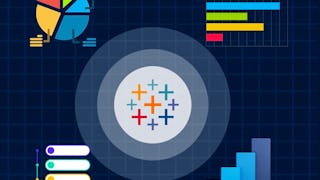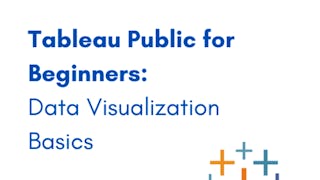In this third course of the specialization, we’ll drill deeper into the tools Tableau offers in the areas of charting, dates, table calculations and mapping. We’ll explore the best choices for charts, based on the type of data you are using. We’ll look at specific types of charts including scatter plots, Gantt charts, histograms, bullet charts and several others, and we’ll address charting guidelines. We’ll define discrete and continuous dates, and examine when to use each one to explain your data. You’ll learn how to create custom and quick table calculations and how to create parameters. We’ll also introduce mapping and explore how Tableau can use different types of geographic data, how to connect to multiple data sources and how to create custom maps.

Cultivate your career with expert-led programs, job-ready certificates, and 10,000 ways to grow. All for $25/month, billed annually. Save now


Visual Analytics with Tableau
This course is part of Data Visualization with Tableau Specialization

Instructor: Suk S. Brar, M.B.A.
73,915 already enrolled
Included with 
(1,836 reviews)
Recommended experience
What you'll learn
Create a chart using Tableau
Create dates using calculated fields
Customize table calculations
Customize and create dual layer maps
Skills you'll gain
Details to know

Add to your LinkedIn profile
4 assignments
See how employees at top companies are mastering in-demand skills

Build your subject-matter expertise
- Learn new concepts from industry experts
- Gain a foundational understanding of a subject or tool
- Develop job-relevant skills with hands-on projects
- Earn a shareable career certificate


Earn a career certificate
Add this credential to your LinkedIn profile, resume, or CV
Share it on social media and in your performance review

There are 4 modules in this course
In this module, you will explore the topic of charting in Tableau. By now you should already be well versed in how to change colors, shapes, and sizes of charts, so we are going to practice and demonstrate that skill more. You will be able to explain what the Tableau Tooltip does and when to use it. You will be able to discuss the various guidelines for choosing the right chart for your data. You will also create a chart using Tableau.
What's included
10 videos2 readings1 assignment1 peer review
This module highlights the important topic of dates within Tableau. You will be able to differentiate between discrete and continuous dates and when to use each. You will be able to use date hierarchies and use the date field to better customize your charts. You will be able to convert between discrete and continuous dates and know when and why you want to switch from one to the other. You will create dates using calculated fields.
What's included
5 videos1 assignment1 peer review
In this module, you will focus on table calculations. You will be able to create new calculated fields to allow you to compare fields, apply aggregations, and more. You will be able use quick table calculations and create new calculated fields. You will be able to customize them and apply filters and parameters to your table calculations.
What's included
6 videos1 assignment1 peer review
In this final module, we will go more in depths about maps within Tableau. You will be able to connect to a different data sources and customize your maps by changing colors, shapes, and sizes. You will be able to custom geocode a map and create Tableau maps with geographic data that is not recognized by Tableau. You will also be able to create dual layer maps and showcase how to overlay maps on top of one another.
What's included
7 videos1 assignment1 peer review1 discussion prompt
Instructor

Offered by
Recommended if you're interested in Data Analysis


University of California, Davis


Board Infinity


Coursera Project Network


Tableau Learning Partner
Why people choose Coursera for their career




Learner reviews
1,836 reviews
- 5 stars
68.26%
- 4 stars
23.51%
- 3 stars
5.49%
- 2 stars
1.68%
- 1 star
1.03%
Showing 3 of 1836
Reviewed on Oct 25, 2020
This has been the most useful course in the Data Visualization with Tableau series. This course teaches practical applications in Tableau. Very well done.
Reviewed on May 23, 2020
OH I LOVE THESE COURSES. SUCH VALUABLE KNOWLEDGE, I AM INTRIGUED.I AM A BIT JEAOLUS ON TO WHY I DID NOT FUMBLE UPON THIS WEBSITE BEFORE AS AN INVESTMENT BANKING MD.
Reviewed on Apr 11, 2021
Practical and useful. The structured introduction to Tableau is great and seems like it would be useful as the second course in the specialization rather than the third course.
New to Data Analysis? Start here.

Open new doors with Coursera Plus
Unlimited access to 10,000+ world-class courses, hands-on projects, and job-ready certificate programs - all included in your subscription
Advance your career with an online degree
Earn a degree from world-class universities - 100% online
Join over 3,400 global companies that choose Coursera for Business
Upskill your employees to excel in the digital economy
Frequently asked questions
Access to lectures and assignments depends on your type of enrollment. If you take a course in audit mode, you will be able to see most course materials for free. To access graded assignments and to earn a Certificate, you will need to purchase the Certificate experience, during or after your audit. If you don't see the audit option:
The course may not offer an audit option. You can try a Free Trial instead, or apply for Financial Aid.
The course may offer 'Full Course, No Certificate' instead. This option lets you see all course materials, submit required assessments, and get a final grade. This also means that you will not be able to purchase a Certificate experience.
When you enroll in the course, you get access to all of the courses in the Specialization, and you earn a certificate when you complete the work. Your electronic Certificate will be added to your Accomplishments page - from there, you can print your Certificate or add it to your LinkedIn profile. If you only want to read and view the course content, you can audit the course for free.
If you subscribed, you get a 7-day free trial during which you can cancel at no penalty. After that, we don’t give refunds, but you can cancel your subscription at any time. See our full refund policy.
More questions
Financial aid available,

